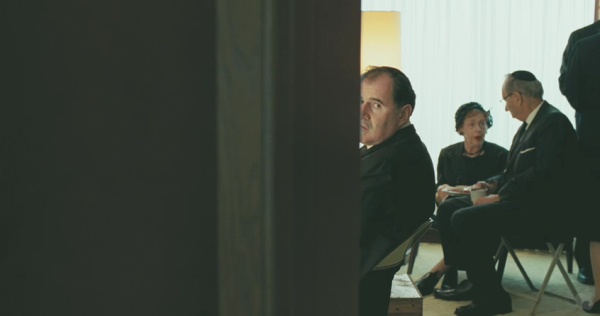David Lynch created Six Figures Getting Sick (Six Times) during his sophomore year at the Pennsylvania Academy of Fine Art, entering it into the school's annual exhibit of experimental painting and sculpture. It represents a first tentative toe into the medium of film for Lynch, who up to that point had primarily worked in painting. Six Figures was originally presented as a one-minute sequence of animated film looped six times, projected onto a sculpted screen that included three casts of Lynch's own head, and accompanied by the sound of a wailing siren.
The version of the film that is included on The Short Films of David Lynch DVD is a surprsingly high-quality transfer, given that the original was a 36-year-old student film. Of course, viewing it in one's home doesn't exactly replicate the experience of the work as Lynch originally intended it. Furthermore, a one-minute snippet of film, which was but one component of a larger multi-media installation, isn't really an example of "cinema" under even the most generous definition. However, Six Figures does provide a valuable embryonic glimpse of the aesthetic sensibility and themes that would come to characterize Lynch's films. Moreover, there is something intrinsically compelling about the first work to post-date the artist's realization that, to paraphrase Lynch himself, his paintings could be paired with sound and made to move.
The film presents a row of six humanoid heads that undergo a violent biological transformation. Fives heads appear in quick succession, left to right, with heads four and five issuing forth pseudopodia that create a sixth. Five figures have a faint digestive system, with the sixth head instead boasting a torso X-ray. The frame rapidly fills with a dark substance that sharply outlines the figures' stomachs and esophagi. Hands appear and fly to the figures' faces--in shame, disgust, or horror, perhaps--and the image flashes red. A red liquid fills each figure's stomach as the word "SICK" flickers on the screen, the hands moving down to clutch or cover the stomachs. Eventually the abdomens ooze white fluid and seem to become scorched, as the figures cover their faces again. Vertical lines of energy and tongues of fire appear over the figures, and a wave of flames moves across the screen. Finally, the frame is filled with purple, and the figures vomit long streams of white fluid.
If you didn't know anything else about it, you might hazard that Six Figures was the work of an art student who adores Francis Bacon and thinks being shocking and incomprehensible is the shortest path to profundity. The former might be accurate--Lynch was and remains a Bacon worshiper--but the latter is a glib dismissal of the film's relatively straightforward presentation of theme. With its repeated motif of fluids that fill up, spill out, and act as catalysts for transformation, Six Figures represents a singularly repulsed reaction to the phenomena of the life cycle. The repetition of both the figures themselves and the shared, violent revolt of their bodies indicates the universality of their experience, implying that however abhorrent their evolution might be, it represents a process that is normal in their reality. The "spawning" of the sixth head and the presence of the X-ray heighten the sense of anxiety: even children are not immune from this sickness, and medical science cannot help them. The looping of the sequence reveals the cyclical nature of this biological violation--it is regular and repeating, not aberrant--and the never-ending siren highlights that this is not a peaceful condition but a state of permanent crisis.
In hindsight, Six Figures dovetails remarkably well with Lynch's later films, which frequently regard biological processes with a combination of disgust and amusement, while also using them as metaphors for cognitive and emotional transformations. In particular, the director's first feature film, Eraserhead, treats childbirth and children as repugnant, partly as an expression of Lynch's own notorious ambivalence towards young fatherhood. Six Figures demonstrates that the director can express this sweeping aversion to the life cycle in a succinct and decisive manner within only a minute of film. Lynch equates symptoms thought of as abnormal (vomiting, bleeding, inflammation, abscessing) with normal biological processes, suggesting that such phenomena--birth, eating, defacating, ejaculating, menstruating, etc.--are all indicative of a sickness. Namely, life itself.
There is no indication as to whether Six Figures regards this wretched cycle of violent illness as humanity's natural state or the result of some contagion. Certainly, although Lynch's career evinces a profound appreciation for the beauty of industrial spaces, it also exhibits a fear of the modern landscape as a hazardous place where people can be contaminated. Thus, we might regard Six Figures as a proto-environmentalist's grim view of the insidious havoc that toxic environments can wreak on humankind, without mercy or discrimination. One can easily imagine Six Figures as the nightmare of Carol White, the chemically sensitive, possibly delusional housewife of Todd Haynes' Safe.
Taken strictly as a first animated film, Six Figures is an auspicious debut for Lynch, showcasing his talent for rendering detailed lines and shapes that accrete in an almost cellular manner. Balancing these are the bold splashes of color and sudden excretions of white liquid that create the film's distressing atmosphere. Lynch would turn to animation frequently in his early works, most conspicuously in his almost witty, Gilliam-like use of human figures in The Grandmother. However, it would be Lynch's next work, his first "real" short film, in which his animation technique is given its most unsettling workout.













